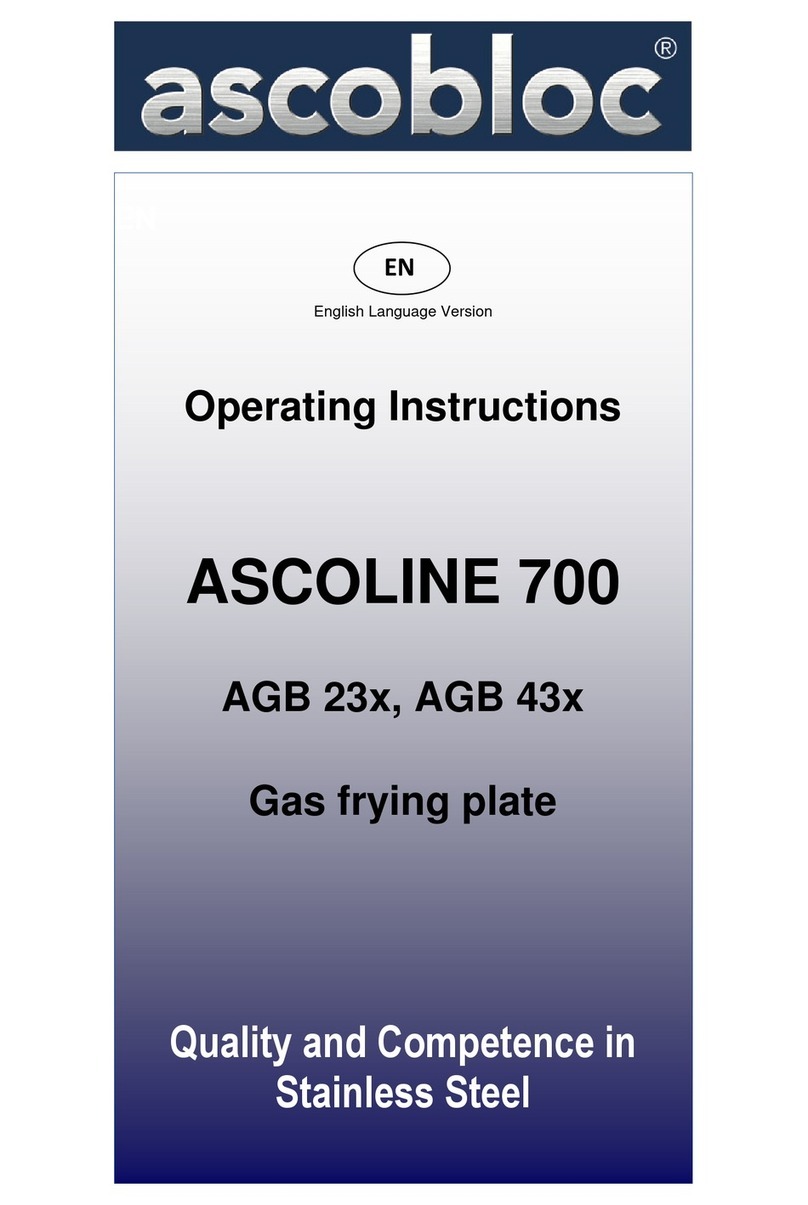
Operating Instructions for Ascoline 700, AES 060, AES 080
ascobloc Gastro-Gerätebau GmbH D - 01156 Dresden, Grüner Weg 29 Germany
Tel.
+49
351
4533-0
Fax
+49
351
4537-339
E-mail:
[email protected] AESxxx.doc Status: 21.06.2019 Subject to change without notice!
4
3.4 Instructions on installation
•The appliance is wired up in the factory as far as the connector. All connection work must be carried
out by an authorised specialist company. Allow the technical experts to look at these documents. The
legally acknowledged regulations (Germany VDE, Austria ÖVE, Switzerland SEV etc.) and the
connection requirements of the local electricity utility are to be observed.
•Before beginning the installation work, it should be checked that the mains voltage, mains type and the
current rating of the circuit breaker match the values given on the name plates. An isolating device in
the customer's scope of supply that is effective on all poles must be provided, e.g. contact breakers
with at least 3 mm contact gaps, so that the equipment is disconnected from the power supply during
repair and installation work. Connection to an equipotential bonding system is available (check
effectiveness).
•Do not sharply bend or crush mains cables or damage on sharp edges and route them so that they
cannot come in contact with hot parts. The power supply cable must be led through the equipment, fully
sheathed, from the screwed connection to the entry of the terminal box. The appliance is intended for a
permanent connection; connection via plug and socket is not permitted
4 Installation
4.1 Setting up
Do not set up the equipment next to walls, kitchen furniture, and decorations or similar which are made of
flammable materials. Otherwise there is danger of fire. See connection diagram with equipment
description for minimum distance. Local fire protection regulations must be kept too absolutely!
The equipment must be set up absolutely horizontal (use spirit level for alignment). Equipment with
adjustable feet can easily compensate for unevenness in the floor (+/- 20 mm) by turning the bottom ends
of the feet. If set up on a plinth, this is to have shims fitted underneath to compensate for unevenness, if
required.
4.1.1 Free-standing set-up
If the equipment is to be set up on its own, suitable means are to be used to protect it against tilting and
shifting.
4.1.2 Setting them up in groups or blocks
When setting up in groups or blocks, the equipment must be joined together by connecting elements
provided for this purpose. This is for the sake of hygiene. Observe equipment setting up sheets or
assembly diagram (data sheet in annex).
4.2 Connections
Details of connections for the media can be taken from the accompanying connection diagram and
equipment description. Check whether the size and position of the electrical connections of the customer
side correspond to the information in the connection plan, equipment description or installation plan
The connections can be made from below or from the rear from a closed installation space. With the
connection from below, the pipe length must be 50 mm above the floor surface.
4.2.1 Electrical connections
The terminal box for the connections is located behind the front panel A (see data sheet). Make the
connections as shown in the annex or in the connection diagram accompanying the equipment. The
number of the connection diagram is to be found on the type plate. Once the electrical connections have
been made, close the cover of the terminal box and screw the front panel in place again
4.2.2 Cold/hot water mixing tap
To connect the appliance to the customer's supply using the hoses supplied with the equipment, the
water hoses must be first unscrewed from the mixing tap. To avoid confusion, undo the hoses one after
the other, reconnect and then secure.
If, after the reconnection, the hoses are too long, make sure that they cannot make contact with
electrically live parts. Only the space between boiler and left panel of the equipment is to be used for
compensation of the excess lengths.
Allowable pressure for the cold tap water connections is max. 600 kPa (6 bar).
4.3 Safety drain valve / discharge strainer
Stick the safety drain valve onto the drain pipe of the boiler and secure with hex-head screws.
If a discharge strainer (accessory) is required, it is fixed in the boiler pan drain line by means of a
clamping strap.
This prevents uncontrolled discharge of fine cooked-food particles.






























